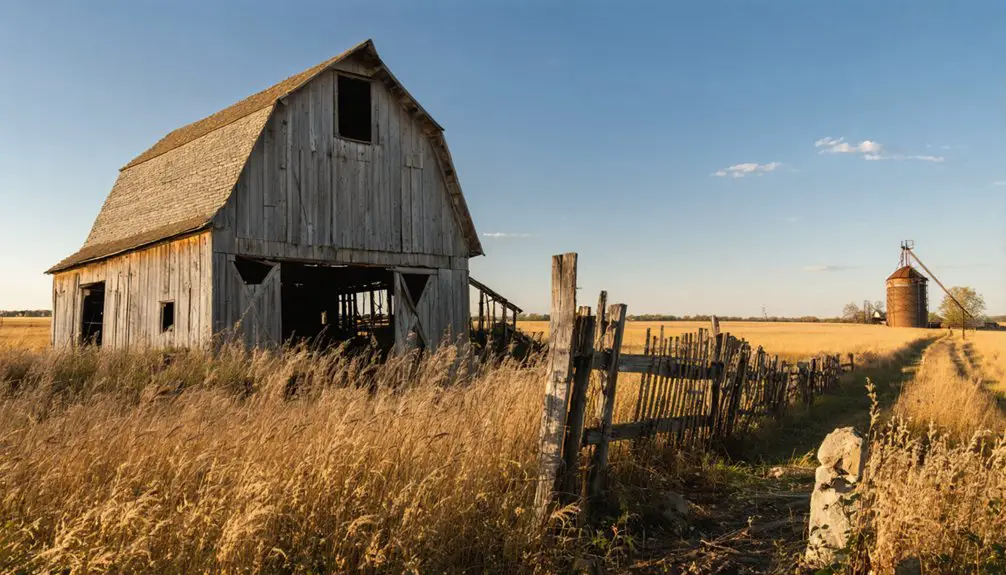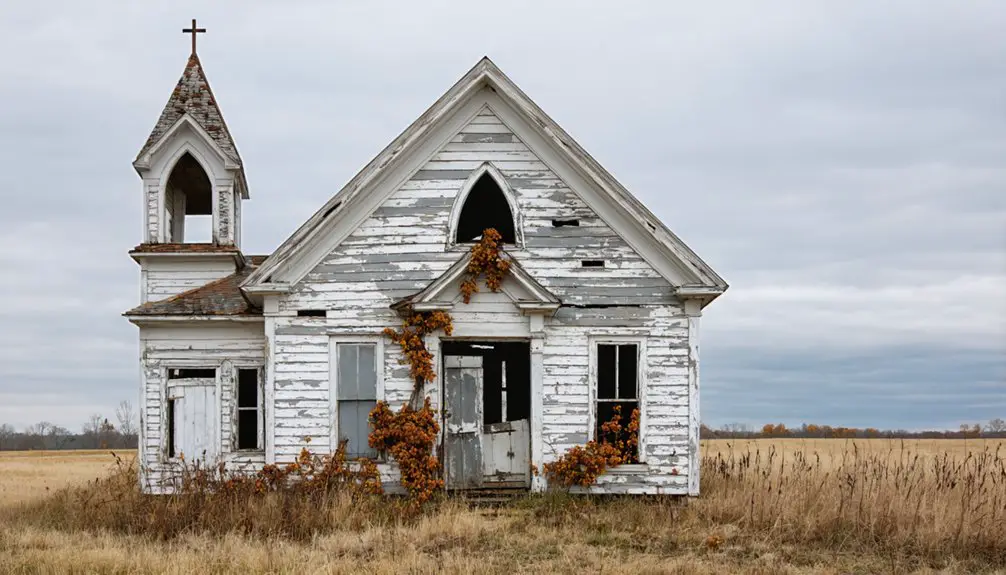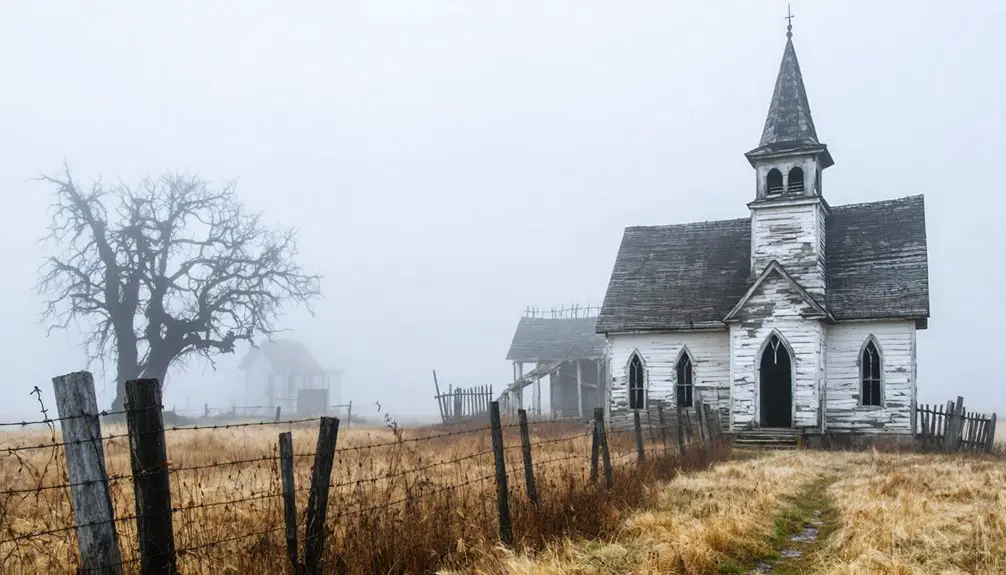You’ll find no trace of Wakenda, Missouri today – a ghost town that vanished beneath the muddy waters of the Great Flood of 1993. Founded in 1818 along Wakenda Creek, this once-thriving farming community of 371 residents fought a constant battle against flooding throughout its history. The devastating 1993 flood destroyed most structures, and by 1995, even the post office closed. The town’s buried foundations and nearby Wakenda Cemetery hold stories of resilience against nature’s unstoppable forces.
Key Takeaways
- Wakenda was a Missouri river town established in 1818 that became a ghost town after the devastating flood of 1993.
- The town maintained a population of 371 residents before flooding destroyed most structures and forced inhabitants to abandon their homes.
- Located along Wakenda Creek, the settlement’s vulnerability to flooding and poor soil conditions ultimately led to its demise.
- The closure of Wakenda’s post office in 1995 marked the official end of the community’s existence.
- Today, only buried foundations and the nearby Wakenda Cemetery remain as evidence of this once-thriving agricultural community.
The Rise and Fall of a River Bottom Settlement
While many frontier settlements faced challenges in their early years, Wakenda’s location proved especially problematic from its inception in 1818.
You’ll find this river settlement’s historical significance traced back to Nathaniel Cary, who first established the community along Wakenda Creek. Originally called Bloomfield, and later known as Eugene City, the town’s position in a low, wet river bottom spelled its eventual doom. The area’s challenging conditions were similar to those that caused Bloomfield’s depopulation in the same year.
Despite the fertile soil that initially attracted settlers, you’d quickly discover why the area earned its reputation as “unfit for the residence of man.” Modern attempts to access historical records of the settlement have encountered database connection issues at local archives.
Fertile land proved a false promise, as nature’s harsh reality rendered this frontier dream uninhabitable for those who dared settle.
The persistent flooding, poor drainage, and widespread cases of ague (malaria) drove families away. What began as a hopeful frontier community gradually succumbed to nature’s relentless assault, until floods and disease ultimately forced its complete abandonment.
Natural Forces Shape Wakenda’s Destiny
You’ll find Wakenda’s fate inextricably linked to the powerful hydrological forces of Wakenda Creek and the Missouri River, whose periodic flooding reshaped the landscape and threatened settlements along their banks.
The town’s location on fertile but unstable soils, formed from loess deposits and floodplain sediments, made it particularly vulnerable to erosion and water table fluctuations. The area’s monthly water balance played a crucial role in the soil stability, as precipitation and evapotranspiration patterns created cycles of saturation and drying.
These natural processes, combined with the region’s drainage patterns and seasonal precipitation cycles, ultimately proved too challenging for permanent settlement, despite the agricultural promise of the river bottom lands. The creek’s path under Missouri Route J created additional flooding risks for the community.
Water’s Relentless Assault
Throughout its history, Wakenda’s destiny has been inextricably linked to the destructive power of water. You’ll find this Missouri town’s story marked by a continuous battle against flooding, where community resilience was repeatedly tested until the devastating 1993 flood delivered the final blow. The post office closed in 1995, marking the end of an era for the community. Like many lost communities across Missouri, Wakenda fell victim to nature’s unpredictable forces.
The town’s location in a flood-prone basin, coupled with inadequate flood management infrastructure, made it particularly vulnerable to nature’s fury.
- Wakenda Creek’s overflow patterns reshaped the landscape, burying structures under layers of silt and debris.
- Persistent flooding undermined building foundations and severed critical infrastructure connections.
- Water-saturated soil conditions created health hazards and limited agricultural possibilities.
The relentless assault of floodwaters transformed Wakenda into a wetland environment, making human habitation increasingly untenable until its ultimate abandonment in the mid-1990s.
Environmental Challenges Prevail
Beyond the immediate impact of flooding, Wakenda faced broader environmental challenges that shaped its ultimate fate.
You’ll find parallels between Wakenda’s struggles and other Missouri communities grappling with environmental degradation. Like Times Beach’s battle with dioxin contamination, abandoned industrial activities across Central Missouri left lasting impacts on soil and water quality. The EPA formally declared Times Beach unsafe and uninhabitable after discovering widespread toxic contamination in the early 1980s. The devastating Dust Bowl conditions of the 1930s had already strained the region’s communities decades earlier.
These environmental pressures tested community resilience, as residents confronted the harsh reality of their changing landscape. While environmental policy evolved to address such challenges through programs like the EPA’s Superfund, many ghost towns never recovered.
Today, nature reclaims these forgotten places, with vegetation spreading across former streets and homesteads – a reflection of both human vulnerability and the environment’s persistent influence on settlement patterns.
Life Before the Great Flood of 1993
Life in Wakenda before the devastating flood of 1993 centered around a close-knit rural community situated near Wakenda Creek’s fertile bottomlands.
Despite challenging environmental conditions, you’d find a resilient township of 371 residents maintaining their rural heritage through agricultural pursuits and local trade.
The community’s spirit endured through their post office, which served as an essential connection to the outside world for over a century, from 1876 to 1995.
- Local families adapted to life in the flood-prone creek bottoms, though they faced ongoing health challenges from the damp conditions.
- The community supported notable residents, including inventor James Fergason, showing the town’s potential despite its modest size.
- Daily activities revolved around farming and small-scale commerce, with residents relying heavily on the surrounding land and waterways.
Many residents maintained strong ties to their local heritage through the historic Wakenda Cemetery, established in 1870 as a central gathering place for the community.
The Day Water Claimed the Town
When the Great Flood of 1993 struck Wakenda in early July, its residents faced an unprecedented deluge that would permanently alter their community’s destiny.
You’d have witnessed local volunteers and National Guard units desperately trying to reinforce levees as the Missouri River rose beyond historic levels, but their efforts proved futile. Despite raising embankments several feet, just inches more rainfall sent waters cascading over the top.
The flood impact was devastating – waters up to 20 feet deep engulfed homes, businesses, and farmland. The damage was part of a larger catastrophe that caused between $12-16 billion in total destruction across the Midwest.
The raging floodwaters showed no mercy, swallowing entire neighborhoods beneath 20 feet of murky destruction.
Community resilience was tested as residents received mandatory evacuation orders by mid-July. They were forced to abandon their properties as contaminated floodwaters and debris rendered structures uninhabitable.
The water remained stagnant for weeks, transforming this once-vibrant river town into a muddy wasteland.
What Remains: Traces of the Past

Today’s visitors to Wakenda’s former site would find little evidence of the once-thriving river town. If you look closely, you’ll spot old foundations buried beneath years of flood deposits and vegetation. Historical documentation confirms that the devastating 1993 floods destroyed or swept away most structures, leaving only sparse archaeological findings beneath the surface.
- The physical landscape remains dominated by Wakenda Creek and flood-prone bottomlands.
- Ground surveys might reveal soil disturbances from past settlement activity.
- Nearby cemeteries and regional archives hold clues to the town’s former inhabitants.
You won’t find any standing buildings or tourist markers at the site. The wet, inhospitable terrain continues to resist human presence, just as it did when flooding forced the town’s abandonment.
Nature has reclaimed what was once developed land, leaving Wakenda’s legacy primarily in historical records.
Lessons From a Lost Community
When you examine Wakenda’s demise along Missouri’s creek bearing the same name, you’ll find nature’s relentless forces – flooding, disease-carrying mosquitoes, and poor drainage – proved too formidable for early settlers to overcome.
You can see how the town’s location in a low-lying wetland area practically guaranteed its eventual abandonment, as recurring bouts of malarial fever and infrastructural challenges wore down the population’s resilience.
The hard lessons of Wakenda’s fate continue to inform modern community planners that successful settlements require careful environmental assessment and sustainable adaptation strategies.
Nature’s Unstoppable Forces Prevail
Despite human efforts to establish a permanent settlement along Wakenda Creek, Missouri’s relentless flooding and environmental challenges proved insurmountable for the community of Wakenda.
You’ll find that nature’s raw power repeatedly overwhelmed any attempts at community adaptation, with the devastating floods of 1993 delivering the final blow to this vulnerable settlement.
- Persistent flooding and poor drainage created unlivable conditions, forcing residents to abandon their homes.
- The low-lying wetland location led to widespread illness and health hazards that diminished the population.
- Natural resilience proved stronger than human determination as flood sediments now cover the town’s remaining foundations.
The story of Wakenda serves as a stark reminder that when you build in nature’s path, you’re at the mercy of unstoppable environmental forces that can erase communities from existence.
Building Smart Saves Communities
The lessons from Wakenda’s demise offer critical insights for modern community planning and survival.
You’ll find that smart planning starts with careful site selection – avoiding flood-prone areas and ensuring proper drainage, unlike Wakenda’s unfortunate positioning along treacherous creek bottoms.
You can’t overlook the importance of robust infrastructure and flood defenses.
While Wakenda’s local levees proved inadequate against nature’s fury, modern communities need engineered solutions that account for extreme weather.
Community resilience depends on thorough emergency preparedness, including state support and volunteer networks.
Even more critical is the need for sustainable environmental management – proper drainage, soil quality assessment, and water management.
When you’re building a community to last, these aren’t just good ideas – they’re essential safeguards against the fate that befell Wakenda.
Preserving Wakenda’s Memory
As floods and time continue erasing physical traces of Wakenda, Missouri, preservation efforts have shifted toward documenting and sharing the town’s legacy through alternative means.
You’ll find community engagement thriving through local historical societies and educational outreach programs, while historical documentation relies heavily on Carroll County archives and DAR markers to maintain the town’s memory.
- Local preservation groups collect oral histories and memorabilia from former residents and their descendants
- Digital archives and online platforms make Wakenda’s story accessible to researchers and history enthusiasts
- Archaeological evidence, though limited by flooding, provides valuable insights when documented through photography and measured drawings
Despite the challenging environmental conditions that prevent traditional preservation methods, you can still explore Wakenda’s heritage through various historical resources and community-driven initiatives that keep its story alive.
Frequently Asked Questions
Were There Any Documented Paranormal Activities in Wakenda Before Its Abandonment?
You won’t find any documented ghostly encounters or spectral sightings during Wakenda’s inhabited period. Historical records focus solely on health issues and environmental challenges that ultimately led to the town’s abandonment.
What Was the Peak Population of Wakenda During Its Most Prosperous Years?
While you’d expect concrete figures for a town’s heyday, Wakenda’s peak population remains unconfirmed, though local demographics and economy suggest it likely housed between 100-300 residents during prosperous years.
Did Any Famous Historical Figures Ever Visit or Live in Wakenda?
You won’t find records of any famous visitors or figures in this town’s history. The available historical records show no evidence of nationally significant personalities ever residing or stopping there.
What Businesses and Industries Operated in Wakenda Before the Floods?
You’d find a bustling rural economy driven by family farms, blacksmith shops, and feed stores. Wakenda’s businesses centered on agricultural practices, with a general store and post office supporting local commerce.
Were There Any Known Native American Settlements in the Wakenda Area?
While native tribes like Osage, Delaware, and Kickapoo lived in Missouri during the 1800s, you won’t find documented settlement history of indigenous peoples specifically at Wakenda Creek before settlers arrived in 1818.
References
- https://urbexunderground.com/ghost-towns-in-missouri/
- https://kids.kiddle.co/List_of_ghost_towns_in_Missouri
- https://collections.shsmo.org/manuscripts/columbia/C2366/carroll-county
- https://www.youtube.com/watch?v=alC1wDdSVvg
- https://en.wikipedia.org/wiki/List_of_ghost_towns_in_Missouri
- http://freepages.genealogy.rootsweb.com/~mogeneal/carrollco.htm
- https://www.iheart.com/content/2023-10-11-missouri-village-named-the-creepiest-ghost-town-in-the-state/
- https://www.youtube.com/watch?v=3ElM_xAtbAY
- https://share.mo.gov/nr/mgs/MGSData/Books/Volumes/Geomorphic History of the Ozarks of Missouri/V-041.pdf
- https://casoilresource.lawr.ucdavis.edu/sde/?series=Wakenda



